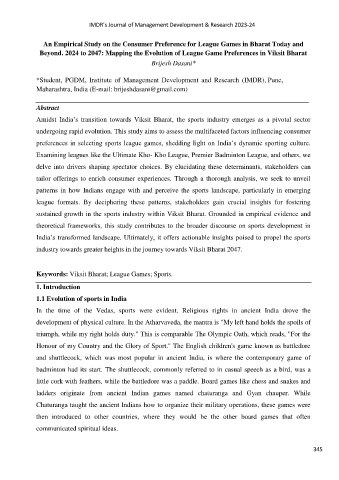Page 353 - IMDR JOURNAL 2023-24
P. 353
IMDR’s Journal of Management Development & Research 2023-24
An Empirical Study on the Consumer Preference for League Games in Bharat Today and
Beyond. 2024 to 2047: Mapping the Evolution of League Game Preferences in Viksit Bharat
Brijesh Dasani*
*Student, PGDM, Institute of Management Development and Research (IMDR), Pune,
Maharashtra, India (E-mail: brijeshdasani@gmail.com)
Abstract
Amidst India’s transition towards Viksit Bharat, the sports industry emerges as a pivotal sector
undergoing rapid evolution. This study aims to assess the multifaceted factors influencing consumer
preferences in selecting sports league games, shedding light on India’s dynamic sporting culture.
Examining leagues like the Ultimate Kho- Kho League, Premier Badminton League, and others, we
delve into drivers shaping spectator choices. By elucidating these determinants, stakeholders can
tailor offerings to enrich consumer experiences. Through a thorough analysis, we seek to unveil
patterns in how Indians engage with and perceive the sports landscape, particularly in emerging
league formats. By deciphering these patterns, stakeholders gain crucial insights for fostering
sustained growth in the sports industry within Viksit Bharat. Grounded in empirical evidence and
theoretical frameworks, this study contributes to the broader discourse on sports development in
India’s transformed landscape. Ultimately, it offers actionable insights poised to propel the sports
industry towards greater heights in the journey towards Viksit Bharat 2047.
Keywords: Viksit Bharat; League Games; Sports.
1. Introduction
1.1 Evolution of sports in India
In the time of the Vedas, sports were evident. Religious rights in ancient India drove the
development of physical culture. In the Atharvaveda, the mantra is "My left hand holds the spoils of
triumph, while my right holds duty." This is comparable The Olympic Oath, which reads, "For the
Honour of my Country and the Glory of Sport." The English children's game known as battledore
and shuttlecock, which was most popular in ancient India, is where the contemporary game of
badminton had its start. The shuttlecock, commonly referred to in casual speech as a bird, was a
little cork with feathers, while the battledore was a paddle. Board games like chess and snakes and
ladders originate from ancient Indian games named chaturanga and Gyan chauper. While
Chaturanga taught the ancient Indians how to organize their military operations, these games were
then introduced to other countries, where they would be the other board games that often
communicated spiritual ideas.
345

